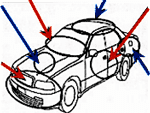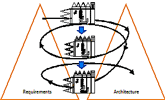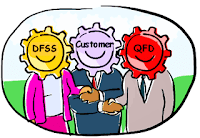This came from someone who read our recent post on healthcare improvement:
I would like to talk about a recent experience I had at a doctor’s office. Given my medical history, the experience might not be relatable to everyone but I think it highlights an important problem in the area of medical process improvement, where offices are adopting new Standard Operating Procedures to streamline patient visits, as a local improvement without seeing the big picture or global improvement.
To start, it’s important to note that I have a long history with eye doctors and have spent my whole life in the same medical system and hospital, and I have a medical record that could rival Proust’s
In Search of Lost Time as a blunt weapon. Like any experienced patient, I know the procedure for checkups and I know how my eyes should test.
On this visit, I made it quickly from the waiting room to the exam room (an area this hospital has made incredible strides in over the past twenty years) and soon my exam was underway. The technician measured my eyesight with a multi-line letter chart and then took my eye pressure using a Tono-pen. Both of my readings were off.
The multi-line letter chart helps prevent cheating through memorization but it makes it much harder to focus on any one line. Tono-pens are used because they save time over traditional Goldmann tonometers (the little blue cones they press into your eyeball) but they are both less accurate and less precise. We’ll get back to the time savings in a minute.
My vision was measured at 20/30, acceptable for many people and good for others. But with my glasses, 20/15 is the norm and 20/20 is what I have on an off-day when I’m tired. It’s not a big delta though and it can vary with things as simple as room dryness or the cleanliness of my glasses, so I was a bit annoyed with the result but not yet concerned. Then came the Tono-pen.
Tono-pens are a small handheld device for measuring intraocular pressure and they’re a godsend for measuring small children and patients who can’t sit still. Unfortunately, I’m not one of them and given my eyes’ history, I have a very precise range of what my eye pressures should be. This particular visit, the pressure in both eyes was abnormally high by more than five; the right eye’s being nearly double its normal value and a possible signal that something might be wrong. The technician’s response was to move me back into a waiting room while my eyes dilated, and advance to her next patient.
All of this was done in a matter of minutes and her efficiency was through the roof! By basic metrics, she did her job swiftly and followed exact protocol for processing patients. After all, it’s not her fault my eyes had subpar measurements; the doctor would just have to treat it.
When my doctor arrived, she began a more thorough investigation of my
eyes. Her conclusion was that everything looked great. All of the parts
in every sector had maintained their shape and size from the last
visit, and there wasn’t a hint of inflammation. Still slightly worried
about the high pressures, I asked if she could re-measure them and she
obliged, this time using the gold standard Goldmann tonometer (photo below). This time, everything was normal.
The point of this writing is not to call attention to a single technician, because she did exactly as she was trained. It is rather to show
what generic service can miss and how it could be better.
Upon seeing and hearing that my eye pressures were out of line, the technician should’ve conducted a second test, possibly using the more accurate and precise equipment, and compared it to my historical figures. The problem with this is that it would’ve cost her time, and being in a low level position, she doesn’t have the clout to shrug off time requirements and quotas.
Now why is it a problem if everyone in a medical office tries to work as quickly as possible?
Mistakes and malpractice aside, it misses the big picture.
The primary bottleneck in a doctor’s office is the doctor herself. They are in least supply, have the busiest schedules and are almost always the reason you’re processed in a timely or slow manner; the rest of the system adjusts around them.
In this case, spending an extra three to five minutes during the technician’s stage would not have delayed my consultation or departure at all, since I still had to wait another 5+ minutes for my eyes to dilate and another 5+ after that for the doctor to become available. The same goes for the next patient she had to visit. If the doctor can only see 5 patients per hour and technicians prepare 10 patients per hour, the clinic will still only fully process 5 patients per hour.
The system can move no faster than the slowest link.
So not only did the time saving measures before the doctor’s stage provide no temporal benefits but in the end, the less precise device actually cost the clinic time it was meant to save. You see, the doctor spent additional time conducting a re-measurement of my eye pressure that actually could’ve taken place twenty minutes prior when there was a buffer zone. Reducing time during the technician’s stage meant overloading the doctor’s stage and the end result was an increase in the total time for processing. As you can imagine, this sort of thing gets compounded with every patient.
In the late Eli Goldratt’s
Theory of Constraints, it was recommended improvements to throughput must come by way of
removing all unnecessary loads from the bottleneck. At a clinic, this means that anything that can be done by a technician should be done with the precision and accuracy that a doctor requires so that they do not have to repeat testing. By increasing the attention to detail of technicians, it may be possible to reduce the overall load on the doctor, thus speeding up the entire system. This could add up to significant savings, especially in these times of concern for reducing healthcare costs for both hospitals and patients.











































